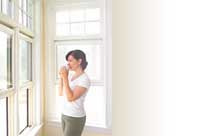Window Replacement: Tax credit helps homeowners get relief from 'sweating' windows
| Tweet |
"Most homeowners, especially in colder climates, have experienced condensation," says Erin Johnson, window expert for Edgetech I.G.
When condensation exists, often so do these three undesirable effects:
* Energy Loss: Inefficient windows, such as those consisting of a single pane or metal-based components, account for up to 35 percent of energy wasted in the U.S. annually. Condensation is a prime indicator that the window is inefficient because it is directly related to heat loss and it even occurs in fairly new insulating glass windows, especially those containing highly conductive metal spacers in the glass system.
* Mold: Visible mold can often be found in poorly insulated or installed windows. Mold is more and more being linked to child asthma and increases in general respiratory illness, allergies and outbreaks of fungal diseases.
* Damage: Excess moisture can damage curtains, walls, carpets and even the window itself, including the frame and sealants. Over time moisture damage can stain wood, peel paint and rot frames. But most importantly, moisture can lead to seal failure and the need to replace the entire window system.
Condensation occurs when moist air comes into contact with a cool surface, such as glass. Windows with metal-based components are especially susceptible to condensation because they conduct heat and cold. Convection currents further concentrate cold air along the bottom edge of glass, making that area most vulnerable.
The primary component to watch for to prevent condensation is the spacer - the window component that separates and seals the two panes of glass. According to the National Fenestration Ratings Council (NFRC), an important step toward reducing the potential for condensation is the use of a warm edge spacer system that reduces the conductivity through the edge of the window.
"Non-metal, double-sealed warm edge spacer systems such as Super Spacer, are less conductive than metal spacers, which leads to less condensation in insulating glass windows," Johnson says. "Because of its all-foam, no-metal design, Super Spacer offers the best condensation resistance in the industry, and it also provides superior thermal performance - saving homeowners money on heating and cooling bills. It also goes a long way in ensuring that windows meet and exceed tax credit requirements for energy-efficient improvements."
Shopping for new windows
The first rule of thumb when shopping for new windows is to understand what the labels mean, and to read them carefully. Windows that bear the Energy Star label are proven to reduce heating and cooling costs, and are NFRC approved for U-factor (the rate of heat loss through the window and Solar Heat Gain, which measures how well the window blocks heat from the sun).
Additionally, some NFRC labels include Condensation Resistance (CR), which is reported on a scale from one to 100, and measures the ability of a product to resist formation of condensation on the interior surface of the product. The higher the CR rating, the better that product is at resisting condensation formation. While this rating cannot predict condensation, it can provide a credible method of comparing the potential of various products for condensation formation. This rating is not required to be posted on new windows - so be sure to do your homework if it isn't there.
"When information isn't immediately available on the window, don't be afraid to ask questions," Johnson says. "Be sure that you are getting a window system with a non-metal spacer and other non-conductive components. A little legwork up front can make all of the difference in ensuring your investment will save you money on energy bills now, and that the window will continue to perform well into the future."
To take advantage of tax credits in the U.S., windows must achieve a .30 U-factor and .30 Solar Heat Gain Coefficient.
For more information on avoiding condensation and its damaging effects, as well as more tips for buying replacement windows that qualify for tax credits, visit www.healthsmartwindows.com.
Courtesy of ARAcontent.


|
Respond Home Improvement Directory lists the top Replacement Window Contractors in your area, organized by specialty and office location. |
| Top Cities | |
|
Atlanta
Chicago New York |
Los Angeles
Philadelphia Washington DC |
| Canadian Cities | |
|
Calgary
Edmonton Ottawa |
Toronto
Vancouver Winnipeg |





